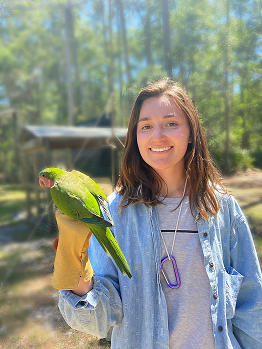The Social Lives of Parrots: Bridging Behavioral Ecology and Conservation
Published:
The Social Lives of Parrots: Bridging Behavioral Ecology and Conservation
Psittaciformes (parrot family) provide an interesting system to study the intersection of behavioral ecology, social cognition, and conservation biology. Parrot species range from critically endangered to highly invasive creating a continuum to explore social relationships and their ecological significance. We have meaningful opportunities to integrate research frameworks with data collection techniques, and analytical tools, and to improve parrot conservation practices.
Parrots are well-known for their highly social nature and have been central to avian cognition studies for decades (Cussen, 2017; Seibert, 2006; Emery, 2006). There are several famous African grey parrots, namely Alex, and Tik-Tik famous Apollo, who know an impressive number of objects, colors, shapes, and concepts.
Many parrot species form dynamic social groups that break apart and reform throughout the day. Within these groups, individuals develop and reinforce affiliative (friendly) relationships by allopreening (social grooming) and allofeeding (regurgitating food to one another). Some parrots may even display prosocial behaviors (check out this blog post about research on African greys). However, sociality may also come at a cost. Parrots also form aggressive relationships and compete for resources, mates, or dominance within their groups (Seibert, 2006).
Most of what we know about parrots comes from captive conditions, often from the pet trade or zoo settings, or stems from research limited to a few individuals (Cussen, 2017), rather than from observations in wild settings (Seibert, 2006). As of 2021, roughly 50 million parrots, 50% of parrots worldwide, live in captivity either as pets, in zoos, or breeding programs (Mellor et al., 2021).
This raises important questions about how captivity affects parrot behavior and how generalizable our knowledge about parrot behavior is. For instance, we often assume that parrots form lifelong pair bonds, but much of this belief is based on pet trade conditions, where birds are housed in pairs rather and are not able to freely choose their partners.
The Conservation Challenge
Currently, of the 410 parrot species (Smith et al., 2023;IOC World Bird List v14.2), 1/3 are threatened by extinction largely due to habitat loss, illegal trade, and climate change (Berkunsky et al., 2017).
This is particularly concerning given that parrots are one of the most imperiled bird groups. Parrots are also slow breeders and ecological specialists, meaning they depend on specific habitats or food sources, making them more vulnerable to environmental changes. As a result, human intervention is playing an increasingly necessary role in their conservation, with methods like hand-raising and reintroducing birds into the wild becoming more common. For example, hand-raising and reintroducing birds is becoming a popular conservation tool to restore native parrot populations (White et al., 2012).
Solutions in non-indigenous species?
On the other hand, the US alone has a striking number of non-indigenous parrot species: there are 56 species and 23 states with breeding populations (Uehling et al., 2019). Their success may be in part due to key aspects of their socioecology and behavioral flexibility, like their ability to form, recover, and maintain relationships.
This may be especially true for monk parakeets. This species is native to South America and is one of the most popular parrot species in the pet trade. Accidental and intentional releases resulted in populations established globally, and they have been the most successful non-indigenous parrot in the US since the mid-60s Uehling et al., 2019.
Their expansion may also be aided by their unique apartment-style stick nests. Unlike most other species of parrots monk parakeets, are not reliant on preexisting tree cavities because they can rapidly build nests with group members Burger & Gochfeld 2009 on a variety of structures, including utility poles. This flexibility and their expansive diet have also allowed them to adjust to urban environments making them common visitors at backyard feeders (Uehling et al., 2019).
It may seem apparent that non-indigenous parrots, like monk parakeets, are unique and may be problematic substitute species to endangered species whose behavior and ecology widely varies. While it is true that generalizations should be made sparingly and cautiously, feral non-indigenous parrot species, like Indian ringnecks and Nandays, offer an important reference point for understanding parrot socioecology and its application to conservation practices.
Studying Wild Parrots: A Difficult Task
Studying parrots in the wild is notoriously challenging which limits researcher’s ability to collect critical data. Parrots are difficult to catch and once they are caught, they are difficult to mark. Most wild bird studies rely on (ethical and harmless) banding or wing tagging for individual identification, but parrots chew off such attachments. Without marking, robust research is nearly impossible. Additionally, most species spend much of their time perched or climbing in tree canopies making them difficult to spot, and often parrots are strong fliers making it difficult to follow and track them once they have taken flight (Skirrow et al., 2024).
While new tracking technologies (such as GPS tags, drones, and AI facial/pattern recognition) have brought us closer to understanding wild parrot behavior than ever before, we are still limited by legislation that prevents direct handling of wild, critically endangered birds in many regions. This presents a major barrier to conducting long-term, detailed behavioral studies on wild populations.
Looking Ahead
Understanding the social lives of parrots is crucial for their conservation and welfare (Baukhagen & Engell 2022), especially as human influence over their survival continues to grow. Studying them in both captivity and the wild can help us better design conservation strategies.

